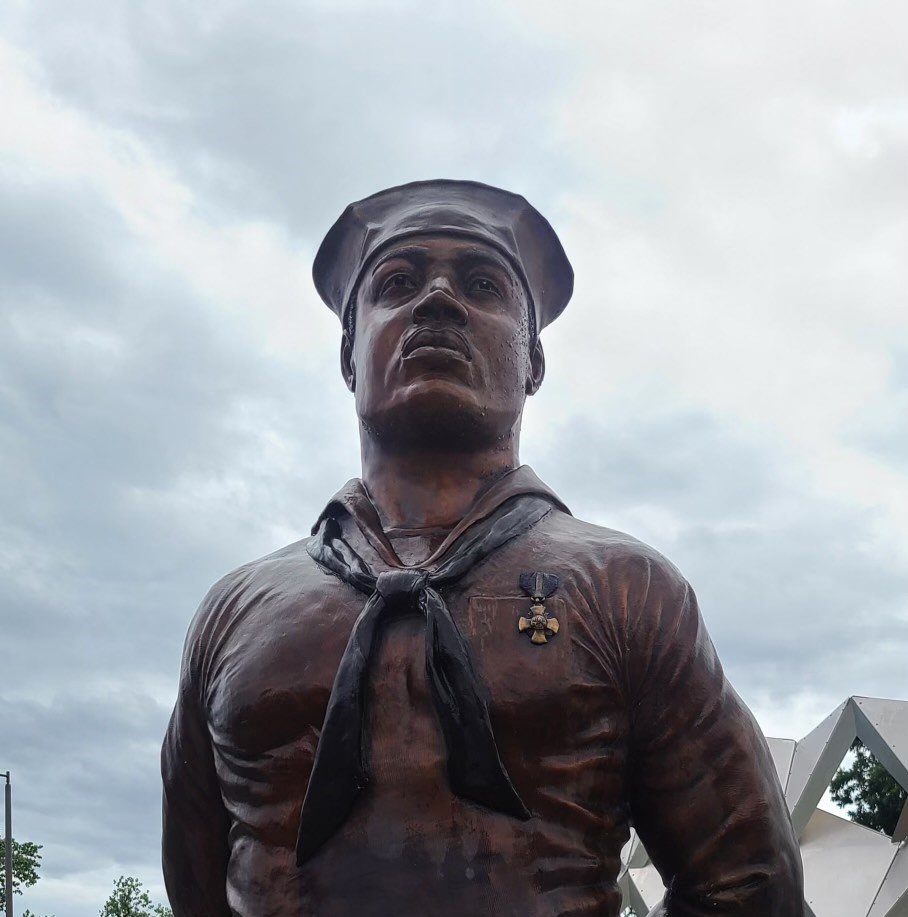by Ryan Yablonski

Rank and status have always been intrinsic to the function of the American military, but this was especially true in the WWII era of 1930’s and 40’s. The larger society of the United States at time was deeply flawed around racial fault lines. While it is true that today more and more stories are emerging of black soldiers who achieved recognition and status during this era; by and large, the structure of the military served as a lens which magnified the social dysfunction of the time. Therefore, the story of the black sailors aboard the USS Indianapolis is a story of racism and classism. But even more so, it is the continuation of a longer story of overcoming adversity through sheer will and meritocracy wherein the black maritime community would not be denied ascension.
Hispanic men aboard the Indianapolis such as Aldofo Reyes, profiled in the previous article in this column, were eligible for mechanical or gunnery positions. White sailors were deemed eligible for combat, command, and intelligence-based officer positions aboard the ship, and deemed ineligible for stewardship ranks. Although all whites were not officers, all officers were white. Officers aboard the Indianapolis lived a very different life than the others. Most of their time was spent on the upper levels of the ship. They ate better food, received more information and training, and were in better position to abandon ship and survive a torpedo event. In relation to this fact, these officers in large part made up the survivors, although history still debates if this was the only factor.
An officer’s daily routine was attended to by stewards. Aboard the Indianapolis, there were 28 members of the enlisted stewards branch, which was entirely black. These stewards blurred the line between rank and file divisions in some ways. They spent more of their time above deck and were often physically in close relation to command personnell. In such a way they formed the historical connective bridge between the past and the future leadership positions that men like themselves would later hold in the Navy.
One such steward who served aboard the Indianapolis has since become one of the most celebrated figures in the American Navy’s history. Combat veteran Doris Miller served on the USS Indianapolis from December of 1941 to May 1943. He was aboard the ship in August of 1942 when it attacked the Japanese staging area on Kiska Island. Miller escaped the sinking of the Indianapolis, but in the end was also swept away in the chaotic tides of that war. He was assigned to the Liscome Bay escort carrier in 1943 when that ship too was torpedoed by a Japanese submarine during the invasion of the Gilbert Islands in November 1944.
Doris Miller’s legacy was made during the infamous Japanese attack on Pearl Harbor. At the time of the attack Miller was assigned to the USS West Virginia as a mess hall attendant. Despite prejudicial mantras at the time which alleged that blacks were not combat ready, those in culinary ranks were still very capable soldiers who were cross-trained to battle stations. Miller himself was a hulking athlete and one of the most feared heavyweight boxers stationed at Pearl Harbor. Miller’s battle station was loading ammunition into anti-aircraft guns. His station was destroyed early in the bombing run and in the ensuing chaos he crossed to the West Virginia’s portside anti-aircraft guns and manned a vacant station by himself. He loaded and unleashed every operable round he could possibly find in the area and provided effective suppressing fire at incoming bombers. Having exhausted the nearby ammunition, Miller stayed aboard the sinking ship, helping injured sailors escape until it was time to swim to shore himself.
After the Indianapolis was lost, Doris Miller was mustered onto the crew of the USS Indianapolis for numerous forays into the Pacific Theater of war. After a brief hiatus, he was later assigned to the USS Liscome Bay. He became the face of Navy recruitment posters, war-bond fundraising campaigns, a Navy Cross recipient, and iconic war hero.
Miller was also grandson of slaves, and son of Texas sharecroppers. His ascension was emblematic of the meritocratic rise of black sea men that began in the WWII era and would blossom in the future years. He is credited by many for beginning to open doors of acceptance within the military tradition for true racial egalitarianism. This is a value which is seen today as one of the American military’s greatest logistical assets. The steward rate in the WWII era was saved by blacks because of the prejudicial idea in the Navy that they would not be good swimmers or members of a combative chain of command. Soon after Miller’s fame spread the Navy began forming all black gun mount teams. One of these new black gun mounts actually did serve aboard the Indianapolis just a couple years later.
In January of 2020, the Navy announced the construction of a new aircraft carrier to be completed in 2026 ; the USS Doris Miller. The poignant truth of his legacy is of how the immutable spirit of dedication that Doris Miller had for our country sparked the erosion of prejudice. The future of this column will explore similar personal stories in relation to legacy of the Indianapolis. It will expand to cover a larger era of black soldiers overcoming adversity at this special point in history.

Hello Ryan,
I enjoyed reading this article about Dorie Miller. However there is so much more to this story. A new book by the daughter of the pilot who discovered the Indy wreckage is now available. It’s called ” Heroes in the Shadows: The Untold Story of the African American Sailors Aboard USS Indianapolis. The author is Jane Godwin-Goodall. Would love for you to connect with her. My cousin was also a member of that ill-fated crew.